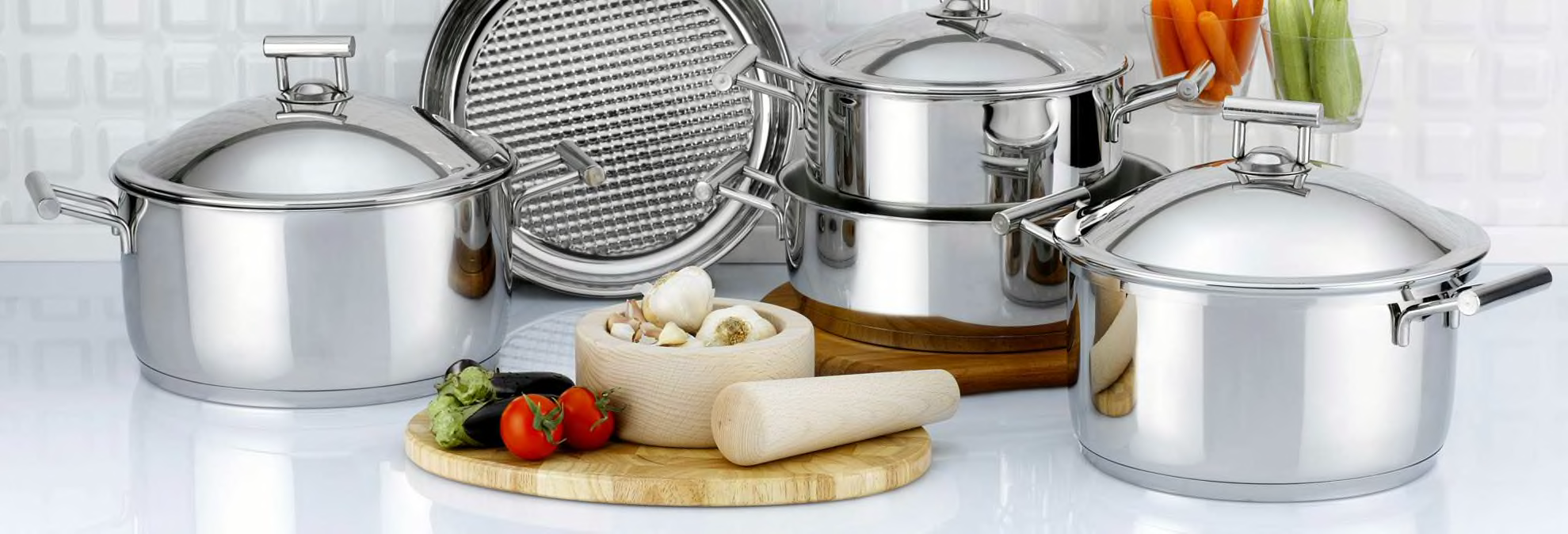
Cookware Buying Guide

Home & Kitchen Writer

Faced with a smorgasbord of cookware styles, materials, and prices—from ceramic-coated to cast iron and stainless to carbon steel—it’s tough to know what you need in your kitchen. What are the differences? And which are best for cooking various types of food?
One thing we’ve learned in our labs at Consumer Reports is that you don’t have to pay a lot for top-performing cookware. In our tests, we find that plenty of budget-friendly sets and individual pans cook just as well as more expensive options.
Don’t have the storage space for a full set? Not to worry. More and more manufacturers are making stackable sets that fit nicely in your cabinet.
Cookware Confidence
Consumer Reports buys and independently tests stainless and nonstick cookware sets, frying pans, Dutch ovens, woks, and more. Undecided about what you need in your kitchen? Here’s what to consider before you start shopping.
Sets vs. Open Stock
Take inventory of the pots and pans you own to determine what needs to be replaced or which new pieces you’d like to have. Many individual pots and pans—called open stock—are widely available. If you need to swap out only a scratched frying pan, open stock is a cost-saving way to go, and it’s the most common way cookware is sold.
If you decide that you want a new cookware set, make sure the pieces in the set you choose complement your cooking style so that you aren’t paying for (and then storing) pans you’ll rarely use.
Consider What You Cook
Think about what you cook frequently. This will influence your choice of pots and pans. For example, if you sear meat often, you’ll want a cast-iron skillet that facilitates even browning. Nonstick frying pans are best for scrambled eggs, pancakes, and delicate foods such as fish. And stainless is perfect for almost any food that needs searing or browning. To help you decide, read about the “Best Frying Pans for the Way You Cook.”
A stock pot is great for soups or boiling pasta, but if you like to cook stews or sauces low and slow, consider a Dutch oven. A Dutch oven can brown, braise, boil, and bake bread, and moves easily from the oven or stovetop to your table. In fact, you can cook almost anything in a versatile Dutch oven. For inspiration, see “Why Every Home Cook Needs a Dutch Oven.”
Match Your Cookware to Your Cooktop
Last, consider how your new cookware pairs with your cooktop. Flat-bottomed pans that don’t warp are essential for a smoothtop range. If you want to cook with a wok, you’ll want a flat-bottomed model too. Gas ranges are a little more forgiving, but you still want good contact between the bottom of the pan and the burner. Cookware with magnetic properties is a must for an induction cooktop. (Consider bringing along a magnet when you shop in person. If it sticks to the bottom, it’ll work with an induction range or cooktop.) Packaging and product descriptions may also indicate whether a piece of cookware or a set is induction-compatible. And in our cookware ratings, we note which pans are induction-compatible.
8 Reasons to Use a Dutch Oven
A great Dutch oven can bake, braise, simmer, and sear, with excellent results. You might consider using one instead of a variety of expensive countertop appliances. Here's how.
The Parts of a Pan
Coating vs. Cladding: What’s the Difference?
"Hard anodized" is a fancy way of saying that the soft surface of nearly pure aluminum has been altered to make it a hard surface. It has nothing to do with the nonstick coating, which allows food to brown without sticking to the pan.
Cladding refers to the layers of metal fused together to create the cookware. So while the outer and inner layers of the pan may be stainless steel, the inside layer may be aluminum or copper, or another conductive or magnetic material. Clad can also mean a material was added to the bottom of a stainless steel pan, enhancing heat transfer.
Familiarize yourself with cookware terminology to make the best choice for your cooking style.
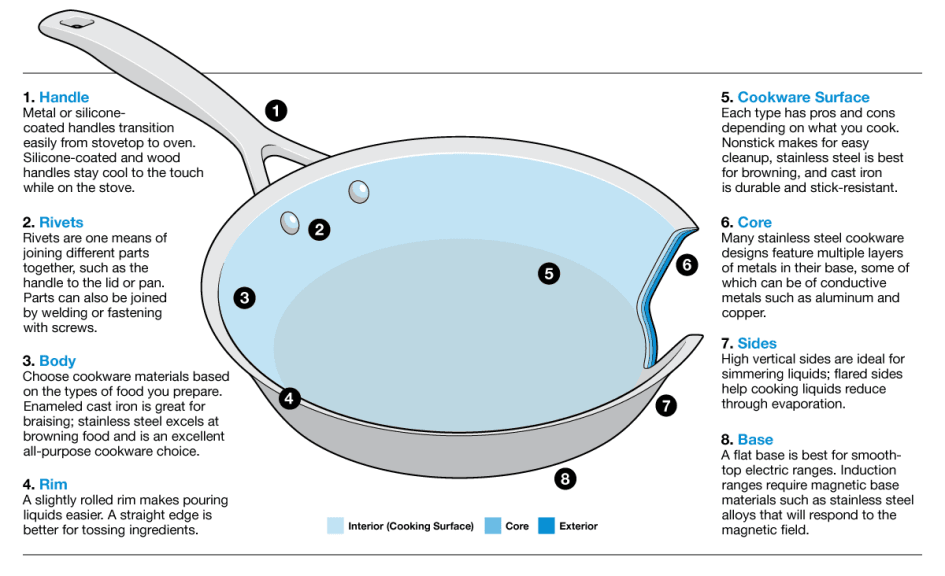
Illustration: Chris Philpot Illustration: Chris Philpot
Shopping Tips
High-quality cookware is at the heart of any serious cook’s kitchen. You need a variety of pots, pans, and casseroles, maybe even a few specialty items. Will a $500 set of cookware be more convenient or make your meals twice as tasty as a $250 set? Not necessarily. Here’s how to build the perfect culinary collection.
Choose Your Pieces
If you’re building a set of cookware from scratch, you will want an assortment of skillets and pots, a stockpot, and lids suited to how you cook and how many people you cook for. In boxed sets, manufacturers count a lid as a piece, and it might fit more than one piece of cookware in the set. A set that contains more pieces might not be the smartest choice if you use only a few and the rest just take up space in your cabinet. Note: Manufacturers may count utensils, lids, and even a cookbook as pieces of a set, so a higher number of pieces might not mean you’re getting more pots and pans.
Pick It Up
Many of us shop online, so take a look at the specs, or—better yet—handle the cookware at a retailer first. See how it feels in your hand. If it’s heavy, think how much heavier it will feel when it’s full of food. Make sure the handles are easy to grasp, the pot or pan is well balanced, and handle attachments are tight and sturdy. Grooves that fit fingers aren’t actually helpful for everyone, especially if you have small hands. Read the packaging to see whether the manufacturer says the cookware can be cleaned in a dishwasher, and even then, consider that you might be better off washing a nonstick pan by hand.
Glass Lids
These allow you to see what’s going on inside the pot without lifting it off, which will let steam escape. But they add weight and can break.
From Stove to Oven
If the box says the cookware is oven-safe, be sure to check the specifics. At what temperature can this cookware safely be used? Some cookware can be used in ovens set to 400° F, and others can withstand higher heat—up to 600° F.
Cookware Types
Choose a cookware material that suits your cooking techniques. For example, sautéed foods turn out best in pans that transmit heat quickly. Braised foods need pans that retain heat over long periods. You shouldn’t cook white sauces or tomato sauces in unlined cast-iron, copper, or aluminum cookware because those ingredients react with the metal.
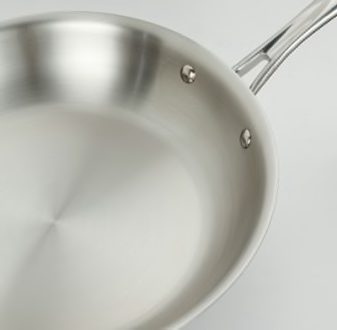
Stainless Steel
Long-lasting, classic, uncoated stainless steel is a good choice for browning and braising. Often sold in sets, stainless cookware can be a kitchen workhorse, tackling everything from pasta sauce to pickling.
Pros: Durable, easy to care for, does not react with foods. Provides rapid, uniform heating. Often magnetic and compatible with induction cooktops. Dishwasher-, oven-, and broiler-safe (depending on the handle material).
Cons: Food can stick, and stainless steel can sometimes be tough to clean. If you choose uncoated, you might still consider a nonstick pan or two to avoid needing so much elbow grease when food sticks.
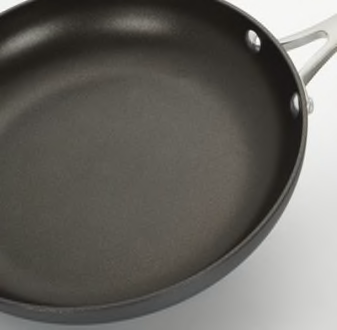
Nonstick
Nonstick cookware has a coating that prevents food from sticking. Good nonstick coatings are durable and effortlessly release even delicate foods, including eggs and pancakes.
Pros: Exceptionally easy to clean. Needs less oil for cooking. Depending on the primary material—typically aluminum—most pieces are ideal for use on any type of cooktop, including induction. Most pieces are claimed oven-safe to 400° F or more.
Cons: Concerns have been raised about chemicals in nonstick pans, particularly PFAS (per- and polyfluoroalkyl substances). According to a recent nationally representative Consumer Reports survey (PDF), while nonstick types of cookware are some of the most popular, a majority of U.S. adults who ever cook or bake are at least somewhat concerned about cookware containing chemicals such as PFAS or PTFE (Teflon), a type of PFAS. Plus, you’ll want to steer clear of using metal utensils with these pans. And high heat in a dishwasher and harsh detergent can shorten their life.
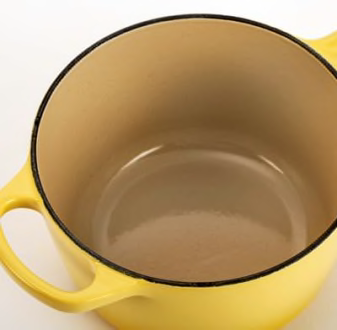
Enameled Cast Iron
Great for searing, sautéing, browning, and frying, these classic, often colorful pieces transition seamlessly from stovetop or oven to your dining table. Covered pieces, like Dutch ovens, are versatile enough to handle braising, stewing, slow cooking, and roasting meat.
Pros: Heats slowly and evenly and retains heat well. Durable coating doesn’t react with acidic ingredients. Dishwasher-safe, corrosion-resistant, and oven-safe to 500° F.
Cons: It’s heavy, and it gets even heavier when filled with food. Small handles on a Dutch oven can make transporting it from stovetop to oven a bit cumbersome. Plus, because cast iron conducts heat, handles can get very hot. Enamel can chip and make them unusable.
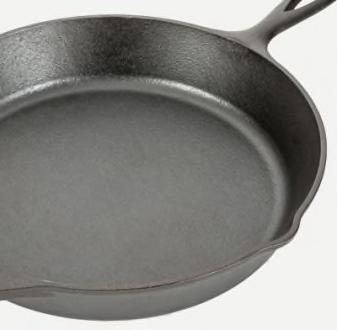
Uncoated Cast Iron
Seasoned cast iron is a great alternative to nonstick cooking surfaces. Lodge, America’s oldest family-owned cookware manufacturer, has referred to its cookware as “natural nonstick.” Cast iron is extremely durable and can be preheated to temperatures that will brown meat. It will also withstand oven temperatures well above what is considered safe for nonstick pans.
Pros: Durable, classic. Moves easily from stovetop to oven, so you can sear a roast, for example, and then continue cooking it in the oven. Some uncoated cast-iron pans are available preseasoned.
Cons: Must be seasoned (rubbed and heated with multiple coats of oil) to avoid rusting. Cleaning it can be a challenge at first, but seasoning makes the task easier. Must be reseasoned with oil from time to time. Not dishwasher-safe. It can rust if left wet or in a damp environment.
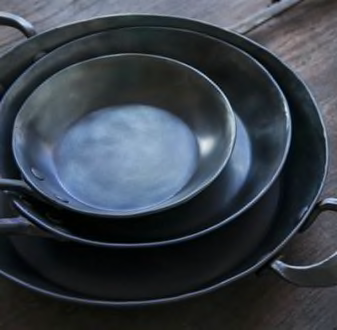
Carbon Steel and Blue Steel
These pans are favorites in professional kitchens because they’re extremely durable and efficient, and designed for high-performance cooking.
Pros: Carbon steel is ideal for use on any type of cooktop, including induction, and is a common material for woks, omelet pans, and crêpe pans. Wipes clean with paper towels. It’s lighter than cast iron and can be used in the same way.
Cons: Pans are often designed for a single purpose. Not dishwasher-safe. Must be seasoned (rubbed with multiple coats of oil) to avoid rusting. Hand-wash only with mild soapy water and a soft brush or sponge.
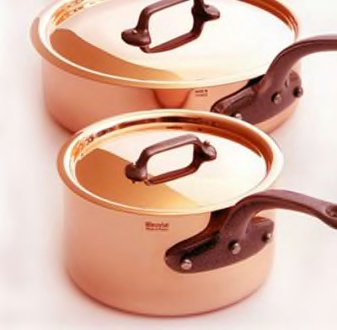
Copper
Real copper cookware provides quick and even cooking, and cools down quickly, providing maximum control. Look for heavy-gauge copper (1⁄16- to 1⁄8-inch thick) for longest wear.
Pros: Ideal for everything from high-heat searing, sautéing, and frying to gently simmering delicate sauces. Offers nice kitchen-to-table presentation. Heavy models with iron or brass handles are safe for oven use.
Cons: Pricey. Can dent easily. Copper is a reactive metal, but today’s pans are usually lined with a nonreactive metal such as tin or stainless steel, which makes them safe to cook in. Usually not compatible with induction cooktops. The outside of a copper pan can take on a patina over time, and if you want to remove it, you’ll need a copper cleaner. Hand-wash only.
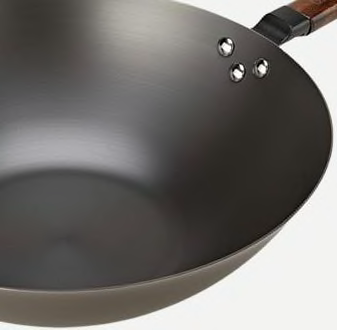
Woks
These pans are designed so you can toss and cook meat and veggies quickly on high heat. You can find woks made of cast iron or with a nonstick coating, but some cooks prefer carbon steel, which is lighter weight and conducts heat well. If you love Asian cuisine, consider adding a wok to your collection. “Confessions of a First-Time Wok Buyer” will help you choose the right one.
Pros: With its high sides, a wok holds more than a skillet, and you can move the food around faster without it spilling over the sides of the pan. You can use a wok on any type of stove, and the flat-bottom woks designed for residential ranges get you good results.
Cons: Home ranges and cooktops can’t approach the level of heat you’d see at your local Chinese restaurant, where the cooks can dial up the temperature much higher than you can at home. And like carbon steel frying pans, carbon steel woks can be a bit tricky to clean until they develop a patina from frequent use and occasional seasoning.
Cookware Brands That Matter
Much of the cookware industry consists of large corporations that manufacture several brands. For example, Meyer manufactures Anolon, Circulon, Farberware, and Rachael Ray brands. Global Home Product brands Mirro, Regal, and WearEver became part of Groupe SEB, which also includes All-Clad and T-Fal. Plus, there are new and trendy names on the market. Use these profiles to compare cookware by brand.
All-Clad is among the highest-priced brands. All-Clad produces mainly stainless steel and copper-core products. These products are distributed primarily in upscale department and specialty stores.
Anolon is manufactured by Meyer and features nonstick products. This brand is priced in the midrange and is sold online and at department stores, specialty stores, mass market retailers, and wholesale clubs.
Actor and chef Ayesha Curry partnered with manufacturer Meyer Corporation to produce cookware, including the budget-friendly nonstick and cast-iron options in CR’s ratings. It’s available on Amazon and Quince, and at Walmart stores.
Actor Drew Barrymore’s cookware brand, manufactured by Made By Gather, includes ceramic nonstick pans that are reasonably priced and can be found on Amazon and at Walmart. Appliances, kitchen gear, and home decor also bear the Beautiful name.
Blue Diamond makes reasonably priced ceramic nonstick cookware that’s sold at retailers including Amazon, Home Depot, Macy’s, Walmart, and Wayfair. Like other inexpensive cookware in our ratings, its handles could stand to be sturdier.
Calphalon is a midrange to high-end brand that is available in various materials—anodized aluminum, nonstick and uncoated, and stainless steel. It’s sold in almost all department stores and specialty stores, at Target, and through numerous online retailers.
Caraway makes trendy ceramic nonstick, stainless steel, and cast-iron cookware, plus kitchen gear in colors that pop. The company claims its pans are free of PFAS, lead, and cadmium. Its cookware can be found at Home Depot and Macy’s, as well as on Amazon and its own website.
The Circulon brand is manufactured by Meyer and features nonstick products. Prices are midrange, and this cookware is available online and in department stores, specialty stores, Bed Bath & Beyond, and Target.
Cuisinart is a mid- to high-priced brand that offers products in stainless steel, hard-anodized, and multiclad materials, nonstick and uncoated. The products are sold at Bloomingdale’s, Macy’s, specialty stores, and numerous online retailers.
Another Meyer brand that is aimed at the mid- to lower-priced market. The brand offers products in uncoated and nonstick stainless steel and aluminum. Products are available at department stores, specialty stores, Kmart, Meijer, Target, Walmart, and numerous online retailers.
GreenPan is a maker of ceramic nonstick and hard anodized cookware, plus bakeware, and small appliances. Its brand name joins actor Stanley Tucci’s on expensive cookware made in Italy that GreenPan claims is PFAS-free. GreenPan cookware can be found at stores like Sur La Table and Wayfair, as well as on Amazon and its own website.
Made In makes traditional nonstick, ceramic nonstick, stainless steel, carbon steel, and enamel-coated cast-iron cookware, plus cooking accessories and dinnerware that are all good-looking but quite pricey. Its wares can be found on Amazon and on the manufacturer’s website.
Maker of the popular Always Pan and cookware sets, Our Place targets consumers looking for more sustainable cookware options. It uses recycled aluminum coated with ceramic nonstick that it claims is free of PFAS chemicals, lead, and cadmium. Its cookware can be found on Amazon, at Target, and on its own website.
Popular cookware, kitchen gear, appliances, and household and baby products bear the Oxo brand name. Its sturdy stainless steel and ceramic nonstick pans and sets are midpriced, and sets in our ratings come with glass lids. Oxo cookware is sold at retailers such as Home Depot, JCPenney, and Macy’s, as well as on Amazon.
Other brands on store shelves include Chefmate, KitchenAid, Le Creuset, Mainstays, Swiss Diamond, T-Fal, Tramontina, Rachael Ray, WearEver, and Zwilling, among many others.



























